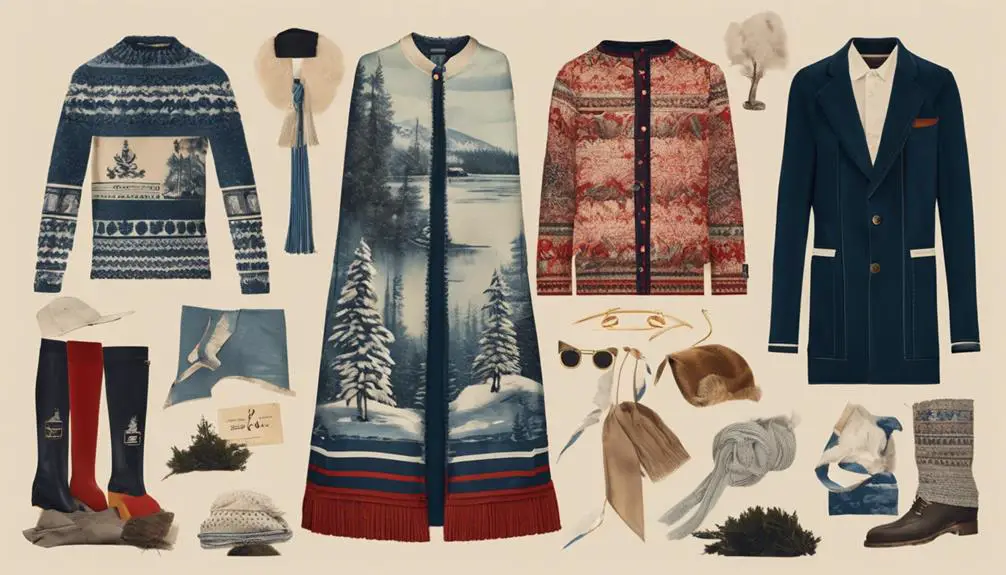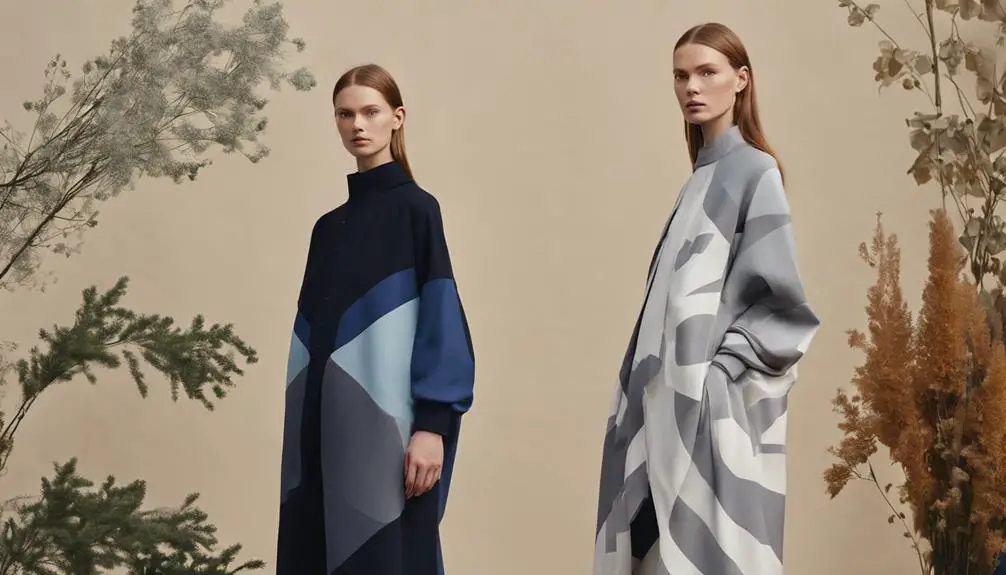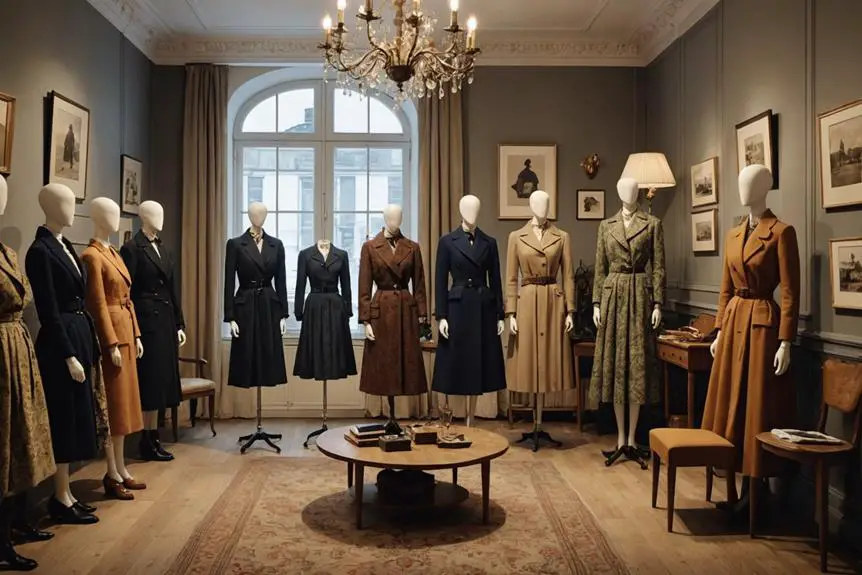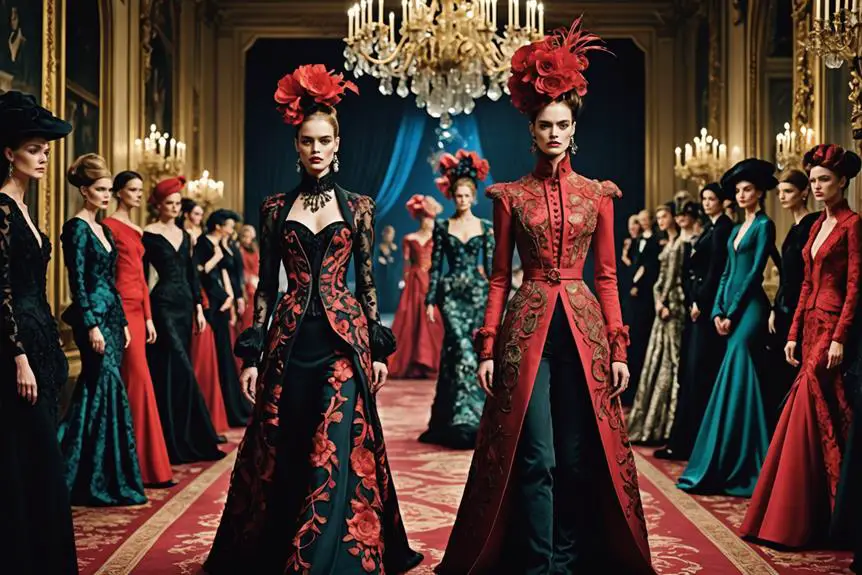If you're curious about the oldest Finnish fashion brands, you'll be excited to discover that Finlayson, founded in 1820, leads the way, showcasing a commitment to sustainability and timeless design. Following closely is Arabia, established in 1873, which has profoundly impacted textile design through its innovative ceramics. Other notable mentions include Nanso, active since 1921, focusing on stylish knitwear, and Sasta, known for durable outdoor clothing. These brands not only highlight Finland's cultural heritage but also its modern commitment to eco-friendly practices. There's so much more to explore about these remarkable brands and their impact on fashion!
Overview of Finnish Fashion History

Finnish fashion history kicks off in the early 19th century, with brands like Finlayson paving the way in 1820. Known primarily for textiles and home goods, Finlayson set a precedent that would shape the future of stylish and sustainable Finnish brands. As you investigate deeper into this vibrant history, you'll discover how the landscape evolved, influenced by both artistry and practicality.
In 1873, Arabia emerged, revolutionizing Finnish ceramics. This brand didn't just focus on tableware; it contributed a unique design aesthetic that trickled into clothing and accessories, enriching the overall lifestyle. Fast forward to the mid-20th century, and you'll find iconic names like Marimekko, founded in 1951. Marimekko popularized bold prints and a commitment to sustainability, ensuring that fashion could be both eye-catching and environmentally friendly.
Then there's Halti, established in 1976, which introduced functional outdoor clothing that's stylish, perfect for Finland's often harsh climate. This brand's dedication to quality craftsmanship resonates with the Finnish ethos of respecting nature while creating beautiful apparel.
Throughout the years, Finnish fashion has been characterized by a strong commitment to sustainability and an appreciation for the natural world. Each of these longstanding brands contributes to a rich narrative that celebrates not just clothing and accessories, but also a lifestyle deeply rooted in quality, craftsmanship, and a connection to the environment. As you explore further, you'll see how this history continues to inspire modern Finnish fashion today.
Iconic Finnish Fashion Brands
When exploring iconic Finnish fashion brands, you'll encounter names that not only define the industry but also embody a deep connection to the country's culture and environment. Marimekko stands out as a true pioneer, known for its vibrant, colorful prints that have made it a household name across the globe. Established in 1951, the brand revolutionized fashion with its bold patterns, celebrating Finnish heritage and creativity, while also emphasizing sustainability.
Another distinguished brand is Finlayson, founded in 1820. As one of Finland's oldest textile brands, it showcases a rich history of high-quality fabrics and designs that reflect the beauty of Finnish nature. Its commitment to craftsmanship and cultural storytelling makes it a staple in Finnish households.
For outdoor enthusiasts, Halti and Sasta are essential Finnish clothing brands. Halti, with over 40 years of experience, specializes in outdoor clothing and gear, ensuring you're well-equipped for Finland's diverse climate. Sasta, on the other hand, has been around for more than 50 years, offering durable outdoor clothing that marries traditional craftsmanship with modern functionality, perfect for tackling extreme conditions.
Lastly, while primarily known for glassware, Iittala has made its mark in fashion with timeless pieces like the Aalto vase, emphasizing functionality and artistic design. These iconic Finnish brands not only represent the best in fashion and lifestyle but also weave together the threads of culture, nature, and innovation that define Finland.
Sustainability in Finnish Fashion

In the domain of fashion, sustainability has taken center stage, with many brands in Finland leading the charge. You'll find that Finnish fashion labels, like Marimekko and Finlayson, are committed to using eco-friendly materials and sustainable production processes, showcasing their dedication to environmental responsibility. These brands not only create beautiful designs but also prioritize the planet, making a positive impact.
One standout brand is Pure Waste, which focuses on producing textiles from recycled materials, promoting a circular economy in the fashion industry. By utilizing discarded fabrics, they help reduce waste while offering stylish options. Similarly, Npra, a sustainable activewear brand, emphasizes minimalist designs and limited shipping choices to cut down on its carbon footprint. This trend towards eco-conscious consumption is becoming more popular, and it's exciting to see!
Moreover, the Finnish fashion scene is increasingly embracing second-hand shopping, with platforms like Vähänkätetty facilitating the buying and selling of pre-owned clothing. This practice not only encourages sustainable habits but also adds a unique flair to personal style. Many Finnish brands are recognized for their dedication to local production, which supports ethical labor practices and minimizes transportation emissions, further enhancing the overall sustainability of the fashion industry.
Cultural Influence on Design
Nature's beauty and cultural heritage profoundly shape the design ethos of Finland's fashion brands. When you explore Finnish clothing, you'll find that brands like Marimekko and Iittala draw inspiration from the breathtaking landscapes surrounding them. Bold colors and organic patterns reflect the essence of Finland, capturing its natural splendor and rich cultural heritage. It's no surprise that Finnish design philosophy emphasizes functionality and sustainability, mirroring the societal values that prioritize eco-conscious living.
You can see traditional craftsmanship woven into the fabric of Finnish fashion, with brands celebrating local artisanship and techniques. This creates an authentic connection to cultural identity and history, ensuring that each piece of clothing tells a story. For instance, Marimekko's iconic Unikko print showcases a perfect blend of modernist principles, where art meets everyday wear, demonstrating that practicality can coexist with aesthetic appeal.
Moreover, the cultural significance of textiles in Finland shines through collaborations between artists and fashion brands. These partnerships not only promote Finnish design on the global stage but also showcase the country's rich artistic traditions. As you explore the world of Finnish fashion, you'll discover that every piece of clothing carries a piece of Finland's heart—its landscapes, its values, and its heritage. Embracing these influences, Finnish brands continue to inspire, reminding us that fashion is not just about style; it's about culture and identity too.
The Future of Finnish Fashion

Finnish fashion is on the brink of an exciting evolution, driven by a commitment to sustainability and innovation. As you explore this dynamic landscape, you'll notice that Finnish brands are increasingly adopting eco-friendly materials and ethical production practices, responding to your demand for responsible fashion choices. This movement towards sustainability not only reflects a growing awareness but also sets a standard for global fashion.
The integration of technology is another key element shaping the future. With virtual fitting rooms and online shopping platforms, Finnish fashion brands create a more engaging and accessible shopping experience for you. This technology allows for a seamless blend of traditional craftsmanship and modern aesthetics, celebrating Finland's rich cultural heritage while appealing to international audiences.
Inclusivity is also taking center stage. The next generation of Finnish designers is prioritizing diverse representation in their collections, ensuring that everyone feels represented and valued. This shift is more than just a trend; it's a necessary evolution in the fashion industry.
Moreover, collaborations between Finnish fashion brands and international designers are enhancing visibility and expanding reach. By working together, they bring fresh perspectives and innovative ideas to the table, enriching the fashion narrative.
As you look to the future of Finnish fashion, it's clear that sustainability, inclusivity, and craftsmanship will continue to play pivotal roles. This evolution not only excites fashion enthusiasts but also paves the way for a more responsible and diverse industry that you can feel proud to support.
Frequently Asked Questions
Which Fashion Brand Is the Oldest?
Did you know that the oldest fashion brand in Finland dates back to 1820? This historic fashion label, rooted in brand heritage, showcases cultural influences through its designs, intertwining Finnish identity with timeless textile craftsmanship.
What Are Finland's Most Known Brands?
When exploring Finland's most known brands, you'll discover Finnish textile innovations and sustainable fashion practices highlighted by contemporary Finnish designers. These brands reflect a unique blend of tradition, functionality, and modern aesthetics that resonate globally.
What Is the Traditional Clothing in Finland Called?
In Finland, traditional garments are called "kansallispuku." You'll find their cultural significance reflected in regional variations, showcasing unique patterns and styles that celebrate local heritage during festivals and national celebrations.
Is Marimekko a Finnish Brand?
Yes, Marimekko's a Finnish brand with a rich history. Its unique designs reflect Finnish design principles, and it's made a significant global influence through bold patterns and commitment to sustainability. You'll love its vibrant collections!





Asking questions are really nice thing iff you are not understanding something completely, but this piece of writing
provides nice understanding even. http://Boyarka-Inform.com/
Asking questions are really nice thing if you are not understanding something completely,
but this piece of writing provides nice understanding even. http://Boyarka-Inform.com/